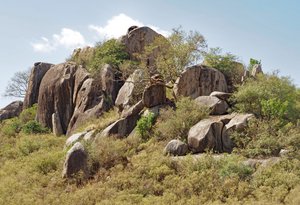Advertisement
Published: September 25th 2023

 Kopje
Kopje
Creates its own microclimateI was so tired last night that I went immediately to bed, slept nine hours, woke thirty minutes before the alarm, and had breakfast on time at 6:00 to leave at 7:00. I pretend I am in a different time zone.
Rather than exiting the Serengeti Park directly, we took a detour to see kopjes. These are strange, worn granite outcroppings, seemingly rising randomly from the flat landscape. In fact, they are the visible evidence of the volcanic history of the plain; underneath the surface are many more giant granite rocks and deposits. The ash and sediment of the volcanos to the east formed the soil of the Serengeti. Erosion has revealed the highest rock surfaces. Now these are fissured and marked by caves, which lions like to use for their dens.
By this time, we were on very rough and virtually unmarked roads, jouncing across the eastern Serengeti and its short-grass savannahs. Rains should come about the end of November. We had a discussion about the similarity of the savannahs to the prairies of North America; Jay Kim, our driver, knew about the prairies from his schooling, thus impressing me with the quality of his lessons. (Later, a

 Cheetah
Cheetah
"What's that noise?"quick internet search revealed that there are grasslands on all continents, except Antarctica, and they cover almost 40% of the land-based world.)
None of the largest predators inhabit this short grassland. Luckily, cheetahs (relatively small) are quite easy to see. Zebras and wildebeest flood the landscape. Grant Gazelles and smaller Thomson Gazelles (nicknamed “Tommies”) wander in large, spread-out harems. Warthogs and their babies trot or run amongst the termite mounds, which are larger and taller in this dry area; sometimes the warthogs are calm enough to eat the roots of grass-like plants.
In this vast dry plain, dust lifted off the road in long plumes. Dust devils danced in the distance. As we neared the park boundary, road graders worked, churning up even more clouds of dust.
My left eye has become irritated, probably with the dust, so today I wore an N95 mask brought for covid protection. Breathing was much easier and clearer – I was surprised at the instant effect. When I took it off at the end of the day, it was coated around the edges and across the front with black dust. Could have been in my lungs!
We had lunch at
the Naabi Hill Gate: chicken in spiced tomato sauce, veggie rice, buns, packaged cookies, juice boxes, bananas, and apples. Lucas’s company, Carnivores Safaris, supplied all the dishes and cutlery, including the containers for the chicken, rice and buns. Much preferable to the boxed lunches from earlier in the trip.
Advertisement
Tot: 0.04s; Tpl: 0.013s; cc: 7; qc: 23; dbt: 0.0182s; 1; m:domysql w:travelblog (10.17.0.13); sld: 1;
; mem: 1.1mb

 Kopje
Kopje 
 Cheetah
Cheetah 























Isabel Gibson
non-member comment
Excellent shots of many birds I've never heard of! The brown snake eagle, the white-bellied bustard (although I know you've posted others of these or similar), the lapwing, that amazing stork. And the cousin to the long-necked stilts I see in Phoenix. Lovely. Am I seeing spikes along the branches of the tree in which the eagle is sitting? As for this "40% of the land surface is grasslands", I remember hearing that for the first time sometime in the last few years. It wasn't something I'd ever wondered about, and I sure wouldn't have had any basis for making a guess. Just another area where my knowledge is sorely lacking.